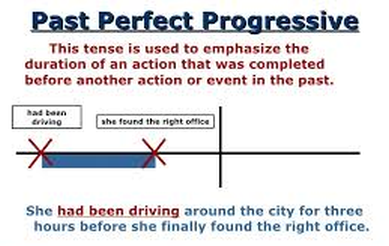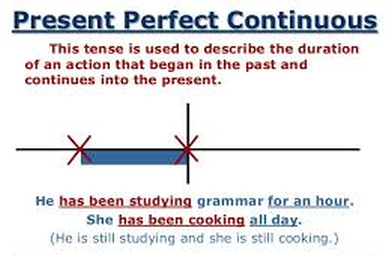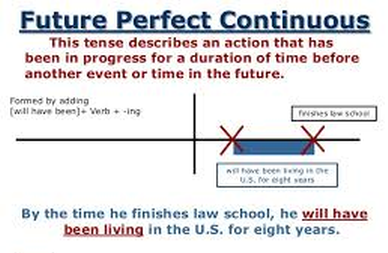In last week’s column, to help dispel a Forum member’s lingering confusion over their usage, I discussed the role of the auxiliary verbs “has,” “have,” and “had” in forming the
present perfect,
past perfect, and
future perfect tenses. Now I’ll discuss the specific timelines for the perfect tenses to show precisely how these auxiliary verbs work to denote them.
 IMAGE CREDIT: WWW.ENGLISHLESSONSBRIGHTON.CO.UKThe present perfect.
IMAGE CREDIT: WWW.ENGLISHLESSONSBRIGHTON.CO.UKThe present perfect. This tense, which uses “has” (singular) or “have” (plural) with the past participle of the verb, works in at least six ways to define events and occurrences as they unfold in time:
(1) To express a state or condition that began in the past and leads up to the present: “The accomplices
have kept their vow of silence for decades.”
(2) To express habitual or continued action: “She
has worn anklets
since she was ten.”
(3) To indicate events occurring at an indefinite time in the past (used with the adverbs “ever,” “never,” and “before”): “Some people
have never gone to college due to poverty.”
(4) To indicate that an action happened only recently (used with the adverb “just”): “My brother
has just finished college.”
(5) To indicate that an action happened more than once, but it is not important or necessary to know exactly when: “She
has seen that movie
a dozen times.”
(6) To indicate that something that happened in the past continues to influence the present: “The El Niño phenomenon
has altered weather patterns very seriously. “
The past perfect. This tense, which uses “had” with the past participle, is used to describe (1) an action completed before another past event, and (2) an action that began and ended at some unspecified time in the past.
In Case 1, the past perfect component is paired off with at least one other past action in the simple past tense: “Rowena
had left to work in Dubai when her scholarship
was approved.” Note that this past perfect sentence consists of two separate actions, one in the past perfect and the other in the simple past.
In Case 2, the present perfect doesn’t require the explicit use of another action completed before another past even: “Rowena
had left.” “The heavy rains
had lasted a month.” In such past perfect sentences, precisely when the action took place is unspecified or unknown. When it is known, the sentence takes the simple past tense: “Rowena
left yesterday.” “The heavy rains
stopped last night.”
The future perfect. This tense, which pairs off the past participle with “will” and “have,” is used in sentences that consist of an action that continues into the future and another action or point of time—expressed in the simple present tense—in which the action culminates or ends. There are four possible scenarios for this:
(1) A future action that will be completed before another time or event in the future: “I
will have taken the board examinations
by 2019.”
(2) An action or condition that will continue up to a certain point in the future: “The nurse
will have worked in Bahrain for six years
by the time she retires.” In such sentences, an existing condition remains unchanged until a specific future time.
(3) A future event that will occur before a specific time or action in the future: “
By the time the irrigation project
is completed, its original cost estimate
will have ballooned almost five times.”
(4) A future event whose completion is more important than how long it will take to complete it: “
By the time she finishes high school, her parents
will have spent a little fortune for her tuition fees.” This use of the future perfect dramatizes the importance of the end-point or result of a process rather than the process itself.
TIMELINES FOR THE PRESENT PERFECT TENSES
Addendum
THE PERFECT PROGRESSIVE OR PERFECT CONTINUOUS FORMS:

 This essay except for the Addendum appeared in the column “English Plain and Simple” by Jose A. Carillo in the Campus Press section of the April 26, 2018 issue (print edition only) of
This essay except for the Addendum appeared in the column “English Plain and Simple” by Jose A. Carillo in the Campus Press section of the April 26, 2018 issue (print edition only) of The Manila Times
, © 2018 by the Manila Times Publishing Corp. All rights reserved.
(Next week:
The present participle and past participle as modifiers - I) May 3, 2018